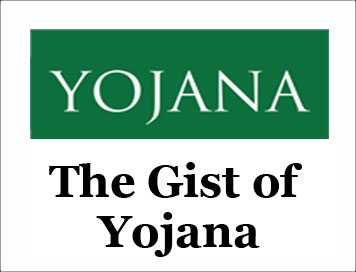(HOT) UPSC Current Affairs 2025 PDF
NEW! The Gist (NOV-2025) | E-BOOKS
(GIST OF YOJANA) WASH FOR WOMEN, WASH FOR THE NATION
GIST OF YOJANA : WASH FOR WOMEN, WASH FOR THE NATION
SEPTEMBER-2025
WASH FOR WOMEN, WASH FOR THE NATION
Context:
India’s rural sanitation and water supply landscape has undergone a remarkable transformation. At the heart of this transformation is the growing leadership of rural women who are now not merely users of the services but are active custodians and change-makers. The growth and evolution we witness today have undergone significant changes over the years.
Gendered Dimensions of WASH:
Traditional Roles of Women
-
Women and girls bear invisible routines: fetching water, managing household sanitation, ensuring family hygiene.
-
These expectations limit their education, livelihood opportunities, and personal agency.
Unique Challenges for Women
-
Menstruation, pregnancy, and menopause create distinct WASH-related needs.
-
Lack of access impacts their health, dignity, safety, and quality of life.
Significance of WASH for Women
• Improvements directly influence women’s wellbeing, education, productivity, and empowerment.
Women’s Leadership in WASH
-
Transformation is rooted in Jan Bhagidari, turning beneficiaries into active stakeholders.
-
Women are still primary managers of household water and sanitation, especially in rural India.
Government Programmes Driving Change
• Swachh Bharat Mission (SBM-G)
• Phase 1 (2014-19): 10 crore toilets built to sanitation coverage rose from 39% to 100%.
• Phase 2 (2020 onwards): 1.75 crore toilets constructed (as of July 2025). 5.18 lakh villages – Solid Waste Management. 5.32 lakh villages – Liquid Waste Management.
Jal Jeevan Mission (JJM):
-
12.43 crore households have been given tap water since launch.
-
15.67 crore rural households covered (as of July 2025).
-
Focus on safe drinking water, women’s leadership, and sustainability.
Institutional Inclusion of Women
-
Earlier: Women were absent from WASH governance and decision-making.
SBM-G and JJM changed this by:
-
Recognising women as central to behaviour change and service delivery.
-
Including them in formal institutional frameworks.
-
Addressing practical gender needs and strategic gender interests.
Guidelines for Inclusion
-
50% of members in Village Water and Sanitation Committees (VWSCs) must be women.
-
Women encouraged to lead in planning, implementing, and managing WASH systems.
Women as Change-Makers
Roles under SBM-G and JJM
-
Swachhagrahis: Mobilising communities, promoting sanitation practices.
-
Jal Sahiyas/Jal Sakhis: Water quality testing.
-
VWSC/SHG members: Managing infrastructure, awareness campaigns.
-
Examples: Dindori district, MP: Maa Narmada Jal Samiti managed entirely by tribal women, overseeing distribution, chlorination, and quality records.
Key Community Platforms
Self-Help Groups (SHGs)
-
Operate community sanitary complexes (cleanliness, fee collection, minor repairs).
-
Drive behaviour change and economic empowerment.
-
Create replicable models for scale with SBM-G and JJM convergence.
-
Village Water & Sanitation Committees (VWSCs)
-
Mandated: 50% women + SC/ST representation.
-
Over 3.2 lakh women in leadership roles (president, secretary, treasurer).
-
Women-led VWSCs linked with:
-
Higher contributions to user charges.
-
Better adherence to hygiene protocols.
-
Faster complaint resolution.
-
Swachhagrahis & Community Resource Persons
• SBM-G Phase 1: 5.5 lakh Swachhagrahis (many women).
• Phase 2: 3.6 lakh active Swachhagrahis.
• Women trained in CLTS, IPC, MHM.
• Example: In UP, MHM clubs led by young girls address taboo issues like menstruation and pit emptying.
Water Revolution Led by Women
-
JJM milestone: 15 crore+ tap connections.
-
Over 24.8 lakh women trained in water testing using FTKs.
-
Women trained in plumbing, system maintenance, distribution management.
-
Represents a deep shift in governance and gender roles, making women frontline managers of lifeline services.
Challenges and Way Forward
Persisting Challenges:
-
Grassroots roles (Swachhagrahis, Jal Sakhis) need better incentives.
-
Women’s participation needs to move from presence to power.
Strategic Actions:
-
Institutionalise Leadership: Make women-led VWSCs and SHG-run initiatives part of KPIs.
-
Capacity Building: Continuous training in planning, finance, grievance handling (via SBM/JJM Academies, e-learning).
-
Women-Owned Enterprises: Enable women to run FSTPs, greywater treatment, MHM units.
-
Data & Recognition: Track women’s roles, reward Gram Panchayats on Swachh Bharat Diwas & Women’s Day.
-
Leverage VHSNCs: Align with VWSCs for sanitation-health convergence.
-
Convergence with Other Ministries: Link with NRLM, WCD, and Panchayati Raj for scale.
Conclusion
WASH is no longer just about infrastructure; it is about empowerment, dignity, and equality. Women’s leadership has redefined community development, showing that when women lead, communities thrive. The mission ahead: build systems where every woman is a water warrior, sanitation entrepreneur, and hygiene champion. Such a model ensures inclusive, sustainable, and enduring national development.
CLICK HERE TO DOWNLOAD FULL PDF
CLICK HERE TO DOWNLOAD UPSC E-BOOKS
Study Material for UPSC General Studies Pre Cum Mains
Get The Gist 1 Year Subscription Online
Click Here to Download More Free Sample Material
<<Go Back To Main Page
Courtesy: Yojana



